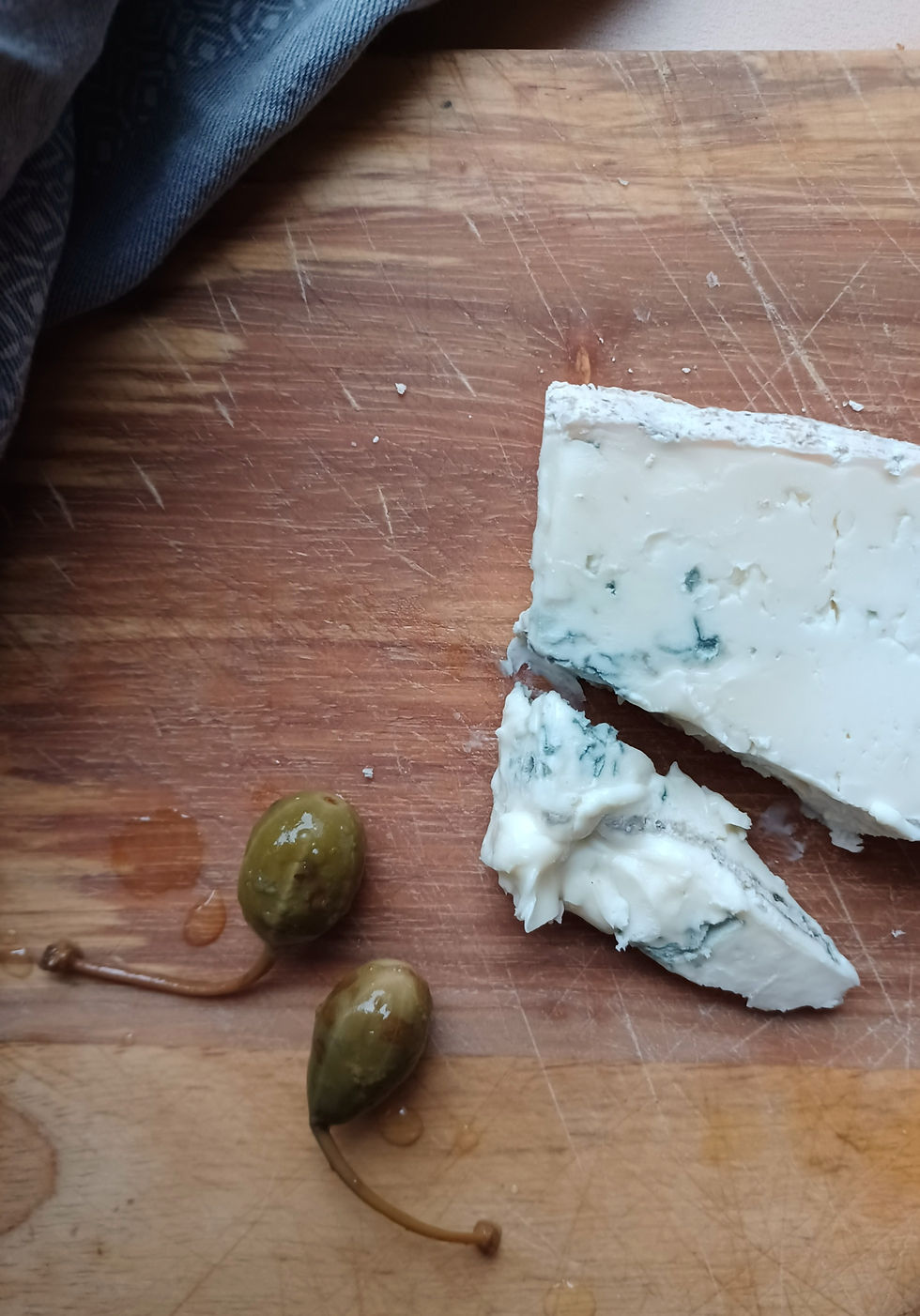Gorgonzola
- Mangia Mangia
- Mar 10, 2023
- 4 min read
Updated: Sep 17, 2024
Not just cheese.

Gorgonzola is a well-known cheese and probably the only Italian blue cheese on your mind, it's creamy or sharp and even found in a version you eat with a spoon but did you know Gorgonzola is also a place?
Like Soave, the wine, and Bibanesi the bread sticks!
Lombardy's fertile plains around Milan are famous for cheese-making. While the origins of creamy, cow's milk gorgonzola become hazy around dates and specific origins, they always remain in this region. It makes sense that the cheese gorgonzola should come from the province of Gorgonzola but in Pasturo nella Valsassina, just east of Lake Como, a series of perfectly temperature-controlled caves are historically famed for ageing cheese. Some say the blue-veined beauty was born here during the Middle Ages but Gorgonzola stubbornly lays claim to gorgonzola so let's leave it at that.
The process
An artisan production rooted in tradition, gorgonzola is still made with the care it was centuries ago from free grazing on rich pastures. A blend of yeasts and rennet is added to fresh cow's milk in tanks where it curdles and the whey is released. Thereafter, the cheeses are brined in sea salt and set to age. It's at this stage that metal rods are pierced quickly into the wheels, permitting air to create the marbling, characteristic moulding of our featured cheese. After 50 days of maturing gorgonzola dolce is officially ready while gorgonzola piccante takes a minimum of 80 days to mature.

The Legend
Yes, you knew it was coming - where there's Italian food, there's Italian legend, here's the gorgonzola one: 'Once upon a time, a thousand years ago, a young, love-struck cheese maker was adding fresh curds to a vat but distracted by love, he walked away, forgot the vat and left the poor curds unattended and open to the elements all night. The next morning, feeling more focused, he realised his error and in an attempt to correct his ways added more fresh curds to the mix. Months went by, the cheese aged and the ragazzo discovered it had also changed colour! Intrigued, he found his 'mistake' rather delicious and made a note of the innovative recipe. Through the power of love and distraction, he'd produced the first moulded, Italian cheese using a process we know now as erborinatura.
Where would we be without love?
Geographically Protected
Since 1996, gorgonzola has been registered as DOP (PDO in English - Protected Designation of Origin) and must be produced solely from dairy cows grazing in specified areas within the regions of Lombardy and Piemonte. As expected, locals eat, sleep and breathe the stuff but gorgonzola is popular outside of Italy too and in fact has quite a few claims to fame!
France and Germany mainly import gorgonzola piccante with its sharp, nutty flavour but the English have always opted for gorgonzola dolce, preferring a milder and creamier cheese compared to Stilton, for example. Such a classic fave in the UK, our wonderful gorgonzola even featured aboard the RMS Titanic! But how about this? Apparently Sir Winston Churchill adored the Italian cheese so much he ordered a ban on bombing anywhere close to Gorgonzola during the Second World War, just in case the creameries were hit - now there's a serious foodie!

Piccante o dolce?
Put the question to an Italian and they'll no doubt have an answer ready because as similar as these cheeses might seem, there's a vast difference in many people's minds. Just ask Alessandro.
Like Churchill, Alessandro is a true gorgonzola fan. Featured in one of our first blog posts ever - Tiramisu in Treviso, our dearest friend takes foodie to the next level. As someone who we often meet for pizza, the question always begs to be asked and hangs in the air until he gestures politely to a waiter and asks, "ma scusi, giusto per sapere, la gorgonzola sulla pizza, è piccante o dolce?"
'Sorry, just to be clear, the gorgonzola on the pizza, is it piccante or dolce?'
He then proceeds to explain how it must be guaranteed 'dolce', otherwise: please bring me a different pizza. Apart from next-level foodie, he's also an endless conversationalist; he'll get stuck into the details of what makes gorgonzola dolce superior until you too are convinced.

Gorgonzola Dolce is a sweet, creamy cheese streaked with blue/green veins of flavour. Dolce translates as 'sweet' but also 'soft' in Italian - perfect for this cheese's 'oozy' nature. In Italy, it is sold from the banco della gastronomia, scooped up into tubs.
Italians love to eat gorgonzola dolce with pear - it's a match made in food heaven. Apple also works, as well as typically walnuts, pumpkin, radicchio and Speck.
It is often added to quattro formaggi pasta sauces, risotti, pizza and bruschette and adored on a tagliere.
Gorgonzola Piccante (also named Mountain Gorgonzola) is aged longer and has a sharp, lingering flavour with an intense tang. The consistency is denser and it holds its shape well - no oozing here.
It works beautifully with Italian meats as an antipasto served with figs, grapes and honey. The blend of sharp and sweet is quite divine, added to its striking blue marbling - the perfect compliment to a glass of Pinot Noir or a beautiful Barolo.
Gorgonzola Crema is a little luxury belonging to the locals. Lasting merely 10 days, this delectable product is eaten straight from the wheel with a spoon. Think of mascarpone in creaminess but with all the gorgonzola flavour - next time you're in the region of Lombardy, find a dairy with tastings!

And if you're ever in the mood to sample an Italian tagliere, find the recipe in our new cookbook Appetito with the glorious gorgonzola featuring in all its grandeur - a feast for the eyes and for the taste buds!
Comentários